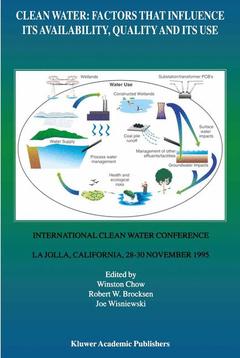Description
Clean Water: Factors that Influence Its Availability, Quality and Its Use, Reprinted from WATER, AIR, AND SOIL POLLUTION, 90:1-2, 1996
International Clean Water Conference held in La Jolla, California, 28–30 November 1995
Coordinators: Chow Winston, Brocksen R.W., Wisniewski Joe
Language: English
Subjects for Clean Water: Factors that Influence Its Availability...:
Publication date: 09-2011
354 p. · 16x24 cm · Paperback
354 p. · 16x24 cm · Paperback
Description
/li>Contents
/li>
ACKNOWLEDGEMENTS IX PART I CONFERENCE SUMMARY STATEMENT R. W. BROCKSEN, W. CHOW, E. D. DAUGHERTY, Y. G. MUSSALLI, J. WISNIEWSKI and A. L. WOODIS I Clean Water: Factors that Influence its Availability, Quality and its Use: Summary of the International Water Conference 3-7 PART II WATER RESOURCE OVERVIEWS S. PECK I Managing and Protecting Our Water Resources 11-20 R. BROCKSEN, W. CHOW and K. CONNOR I Addressing Electric Utility Surface Water Challenges 21-29 C. LOHSE-HANSON I Lake Superior Binational Program: The Role of Electric Utilities 31-40 J. A. VEIL and D. O. MOSES I Consequences of Proposed Changes to Clean Water Act Thermal Discharges 41-52 PART III ECOLOGICAL I HEALTH RISKS c. SEIGNEUR, E. CONSTANTINOU and L. LEVIN I Multipathway Health Risk Assessment of Power Plant Water Discharges 55-64 C. W. CHEN, J. HERR, R. A. GOLDSTEIN, F. J. SAGONA, K. E. RYLANT and G. E. HAUSER I Watershed Risk Analysis Model for TVA's Holston River Basin 65-70 S. FERSON, L. R. GINZBURG and R. A. GOLDSTEIN I Inferring Ecological Risk from Toxicity Bioassays 71-82 C. ARQUIETT, M. GERKE and I. DATSKOU I Evaluation of Contaminated Groundwater Cleanup Objectives 83-92 G. L. BOWIE, J. G. SANDERS, G. F. RIEDEL, C. C. GILMOUR, D. L. BREITBURG, G. A. CUTIER and D. B. PORCELLA / Assessing Selenium Cycling and Accumulation in Aquatic Ecosystems 93-104 D. W. RODGERS, J. SCHRODER and L.
I Conference Summary Statement.- Clean Water: Factors that Influence its Availability, Quality and its Use: Summary of the International Water Conference.- II Water Resource Overviews.- Managing and Protecting Our Water Resources.- Addressing Electric Utility Surface Water Challenges.- Lake Superior Binational Program: The Role Of Electric Utilities.- Consequences Of Proposed Changes To Clean Water Act Thermal Discharges.- III Ecological / Health Risks.- Multipathway Health Risk Assessment of Power Plant Water Discharges.- Watershed Risk Analysis Model For Tva’s Holston River Basin.- Inferring Ecological Risk from Toxicity Bioassays.- Evaluation Of Contaminated Groundwater Cleanup Objectives.- Assessing Selenium Cycling and Accumulation in Aquatic Ecosystems.- Comparison of Daphnia Magna, Rainbow Trout and Bacterial-based Toxicity Tests of Ontario Hydro Aquatic Effluents.- Use of the Pisces Database: Power Plant Aqueous Stream Compositions.- RIVRISK: A Model to Assess Potential Human Health and Ecological Risks from Chemical and Thermal Releases into Rivers.- Risks Due to Groundwater Contamination at a Plutonium Processing Facility.- TVA-EPRI River Resource Aid (Terra) Reservoir and Power Operations Decision Support System.- IV Control Strategies.- Best Management Practices for Storm Water at Industrial Facilities.- Coal Sorbent System for the Extraction and Disposal of Heavy Metals and Organic Compounds.- The EPRI State-of-the-Art Cooling Water Treatment Research Project: A Tailored Collaboration Program.- The Use of Reclaimed Water in Electric Power Stations and Other Industrial Facilities.- Reactive Solute Transport in Acidic Streams.- Constructed Wetland Treatment Systems Applied Research Program at the Electric Power Research Institute.- Toxicity Reduction ofOntario Hydro Radioactive Liquid Waste.- Electricity and Water Desalination: Separate Sites Offer Value.- V Measuring Quality.- Impact on Discharge Monitoring of Recent EPA Initiatives in Water Quality Measurement.- Trace Metal Speciation in Natural Waters: Computational vs. Analytical.- Metal Speciation: Survey of Environmental Methods of Analysis.- The Effect of Membrane Filtration on Dissolved Trace Element Concentrations.- Residual Sulfite After Dechlorination of Water.- VI Water Resources.- The Modular Modeling System (MMS) — The Physical Process Modeling Component of a Database-Centered Decision Support System for Water and Power Management.- Validation and Sensitivity of a Convective Precipitation Model for Mountainous Areas.- Predictive Techniques for River Channel Evolution and Maintenance.- Response of Snowmelt Hydrology to Climate Change.- Conference Participants.- Author Index.- Key Word Index.
© 2024 LAVOISIER S.A.S.




